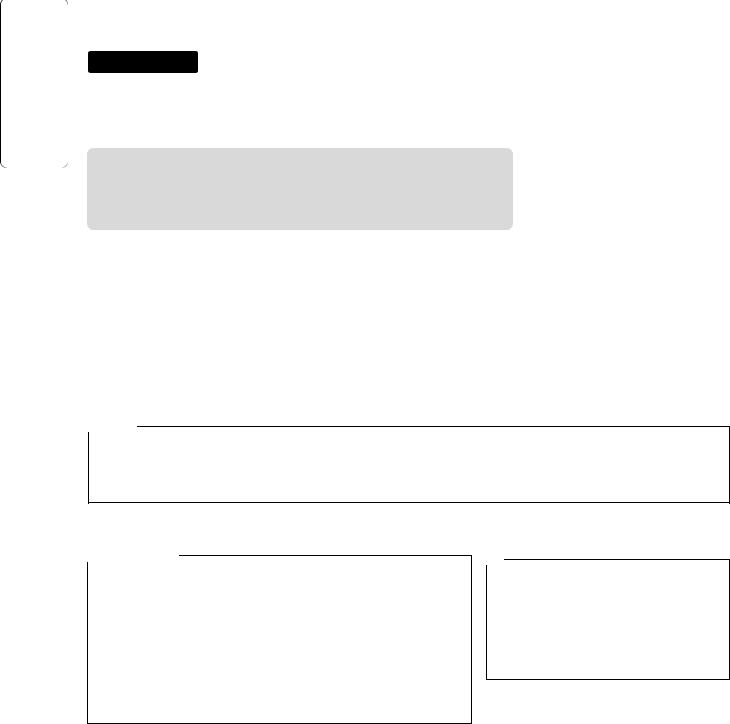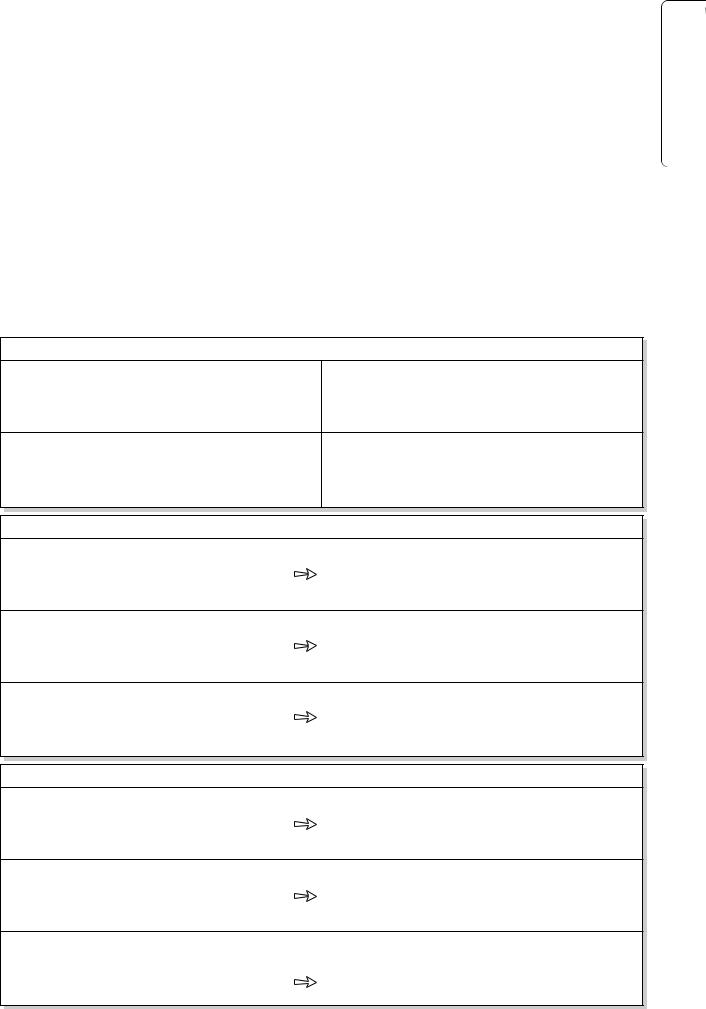
Frameworks
.pdf
4 Customer needs
1Brainstorm.
1What do customers want? Add examples to the following lists.
Before purchase: design, information,
At the point of sale: choice, demonstrations,
After purchase: good handling of complaints, maintenance/servicing,
2Add some special needs for each of the following types of customer.
Manufacturer: keeping delivery schedules,
Wholesaler: capacity to deal with fluctuating orders, Retailer: national advertising of brands,
Service sector customer: top-quality information about benefits to the final customer,
Consumer/End user: a long, trouble-free operational life of goods and services,
2 How does your company focus on customer needs? Write notes.
MANAGEMENT
After-sales
R&D
Sales Production
 Distribution Marketing
Distribution Marketing 
3 Discuss.

MANAGEMENT
Teacher’s notes Management: 5 Improving customer relations
5 Improving customer relations
Before you start
1Are your students interested in this topic? Use the checklist on page 7.
2Which classroom management options will you follow? See pages 4–5.
3Do your students need language support for the discussions? See page 8.
1 Prepare.
Tasks 1, 2 and 3
1Divide the students into small groups and get them to answer the questions.
2Elicit answers from the groups.
(See Possible answers/ideas box below.)
Tip
In number 3, a is a general question with possible answers in the box below. Questions b and c are potentially controversial and so are best dealt with lightly and quickly, especially in an in-company group.
Possible answers/ideas
3a Customer satisfaction can be measured by:
the number of complaints, number of compliments, number of customers repurchasing the same product, number of returned products, number of warranty claims, number of sales coming from recommendations of existing customers, how successful you are at cross-selling other products, figures for the duration of the business relationship, figures for the frequency of orders, number of lost customers and analysis of why you lose business.
3c Customers complain about:
late delivery, wrong goods delivered, wrong number of goods delivered, right model but wrong colour, goods faulty/broken/damaged on unpacking, goods don’t match specifications/expectations, wrong information on paperwork (delivery note/invoice/credit note/statement), omission of documentation such as warranty card/manual, misleading promotional material, unavailable product information, rude and unhelpful sales staff.
2 How are you improving customer relations? Write notes.
1 Focus attention on the grids and |
Vocabulary box |
|
check the vocabulary in the headings. |
|
this includes brochures, catalogues, leaflets etc. |
printed material: |
||
(See Vocabulary box below.) |
reliability (n)/reliable (adj): a reliable product is one that you can |
|
|
depend on. |
|
|
environmental profile: this includes use of recycled materials, |
|
|
biodegradability, production of waste products during manufacture etc. |
|
|
|
|
2Circulate while students make notes. Write down on a piece of paper any useful language needed or produced. Write a few language items of general interest on the board at the end.
Tip
If students can’t get started because they feel that customer relations are already good, ask them to write about improvements they made in the past. Other prompts that may be useful include: General issues: your image in the press and media? staff independence to make decisions?
Customer service issues: staff training? flexibility of staff? response times? your customers’ ease of access to relevant staff? warranty (guarantee) arrangements?
3 Discuss.
1Which classroom management options will you follow? See pages 4–5.
2Circulate during the discussion. Make a note of good/bad language use.
Feedback slot
See page 5.
Extension
●Write the following titles on the board and ask students to tell a personalized story about one of them: ‘How I turned a complaint into an opportunity’, ‘The angriest customer I ever had and how I dealt with him/her’, ‘The internal market in my company: now my colleagues are my customers’.
●Students can write a short summary of how to improve customer relations in their company.

5 Improving customer relations
1 Prepare.
1Tell other students about an experience you had of excellent customer service.
2Tell other students about an experience you had of very bad customer service.
3a How can customer satisfaction be measured?
b How does your company measure customer satisfaction?
c What do your customers complain about? Why do you lose business?
2 How are you improving customer relations? Write notes.
General issues
|
Company image |
|
Company culture, including top-management |
|
|
|
|
leadership and middle-management support |
|
|
|
|
|
|
|
|
|
|
|
|
|
Customer service issues |
|
|
|
|
|
|
|
|
Behaviour and |
Printed material |
After-sales support |
Handling complaints |
|
product knowledge |
(catalogues etc.) |
|
|
|
of sales staff |
|
|
|
|
|
|
|
|
|
|
|
|
|
|
|
Product issues |
|
|
|
|
|
|
|
|
Quality and reliability |
Design and appearance |
Distribution and delivery |
Environmental profile |
|
|
|
|
|
|
|
|
|
|
|
|
Using customer relations to develop the business |
|
|
|
|
|
||
|
Using customer relations to identify new |
Using customer relations to identify |
||
|
products and markets |
|
opportunities for better financial performance |
|
|
|
|
|
|
|
|
|
|
|
MANAGEMENT
3 Discuss

MANAGEMENT
Teacher’s notes Management: 6 Managing change
6 Managing change
Before you start
1 Are your students interested in this topic? Use the checklist on page 7. 2 Which classroom management options will you follow? See pages 4–5.
3 Do your students need language support for the discussions? See page 8.
1 Prepare.
Task 1 |
Tip |
|
|
Give students time to think of examples from their |
It |
isn’t necessary for every student to cover every point. |
|
Ask students to think of just one or two examples each |
|||
own company. Then get individual students to tell |
|||
from the list and then tell the class. |
|||
the rest of the class. |
|||
|
|
||
Task 2
1Check students understand that the vocabulary items are all collocations related to managing change. Get students to fill in the missing vowels. Then check the answers. (See Answers box below.)
Answers
1 to cause / identify / acknowledge / face / be faced |
3 to allocate / delegate / carry out / perform / complete |
with / deal with / overcome a problem |
a task |
2 to draw up / introduce / roll out / monitor / carry out / |
4 to complete the change on time / late / within budget / |
consolidate a change programme |
over budget |
2 Check comprehension of the vocabulary items. (See Vocabulary box below.)
Vocabulary box
to acknowledge: to accept that something is true to face: to have to accept and deal with
to overcome: to succeed in dealing with or controlling a problem; to solve a problem
to draw up: to think of and plan
to roll out: to introduce a new system (or to launch a new product) to monitor: to check the progress of
to carry out: to do something that needs to be organized and planned to allocate: to give something officially for a particular purpose
task: a piece of work, a job
Tip
For higher-level groups, write up the words a reactive/proactive response to a situation and elicit the meaning: a reactive response is when change is forced on you because a problem happens; a proactive response is when you prepare for change because you see a problem before it happens.
2 Write notes about a major change that you helped (or will help) to manage.
1 |
Focus attention on the grids and check the |
Tip |
|
|
vocabulary in the headings. |
The following are possible ideas for why change is/was |
|
2 |
Circulate while students make notes. Write |
necessary in the Background box: |
|
|
down on a piece of paper any useful language |
restructuring: changing the way that a company is |
|
|
needed or produced. Write a few language items |
organized or financed |
|
|
of general interest on the board at the end. |
downsizing: a reduction in the number of employees |
|
3 Discuss. |
a merger: when two companies join together to make one |
||
an acquisition: when one company takes over another |
|||
1 |
Which classroom management options will you |
i.e. buys a majority or all of the shares of another |
|
2 |
follow? See pages 4–5. |
|
|
|
|
||
Circulate during the discussion. Make a note of good/bad language use. |
|||
Feedback slot
See page 5.
Extension
●Students can write a short summary of the process of managing change.
●Consider repeating the activity in a later lesson e.g. with a different partner. See page 5.

6 Managing change
1Prepare.
1Give examples from your company of when the following things needed to change:
●tasks, job designs, business objectives
●attitudes and skills of employees
●the company culture
●operations technology and information technology
●the structure of the organization, including lines of authority and communication
2Fill in the missing vowels in these words and check the meaning.
1 |
to |
c_ _s_ / _d_nt_fy / _ckn_wl_dg_ / f_c_ / b_ f_c_ d |
w_th / d_ _l |
w_th / _v_rc_m_ a problem |
|
2 |
to |
dr_w _p / _ntr_d_c_ / r_ll |
_ _ t / m_n_t_r / c_rry |
_ _t / c_ns_l_d_t_ a change programme |
|
3 |
to |
_ll_c_t_ / d_l_g_t_ / c_rry |
_ _t / p_rf_rm / c_mpl_t_ |
a task |
|
4 |
to complete the change _n |
t_m_ / l_t_ / w_th_n b_dg_t / _v_r |
b_dg _ t |
||
2 Write notes about a major change that you helped (or will help) to manage.
Background
|
What is/was the change? |
Why is/was it necessary? |
How did you know? |
||
|
|
|
|
|
|
|
|
|
|
|
|
|
|
|
Action Plan/Tasks |
|
Results |
|
|
|
|
|
|
|
Design: agreeing on the vision, |
|
|
|
|
|
building the team, |
|
|
|
|
|
obtaining consensus |
|
|
|
|
|
|
|
|
|
|
|
Planning: developing the plan, |
|
|
|
|
|
allocating resources, |
|
|
|
|
|
agreeing on the timescale |
|
|
|
|
|
|
|
|
|
|
|
Implementation: roll out of |
|
|
|
|
|
change, communicating |
|
|
|
|
|
with stakeholders, |
|
|
|
|
|
overcoming resistance |
|
|
|
|
|
|
|
|
|
|
|
Consolidation: monitoring |
|
|
|
|
|
progress, minimizing negative |
|
|
|
|
|
effects, providing support |
|
|
|
|
|
|
|
|
|
|
|
|
|
|
|
|
|
Evaluation |
|
|
|
|
|
|
|
|
|
|
|
|
|
|
|
|
MANAGEMENT
3 Discuss.

MANAGEMENT
Teacher’s notes Management: 7 Company strategy
7 Company strategy
Before you start
1Are your students interested in this topic? Use the checklist on page 7.
2Which classroom management options will you follow? See pages 4–5.
3Do your students need language support for the discussions? See page 8.
1Prepare.
1Get students to check the meaning of the phrases in pairs. Then check with the whole class. (See Vocabulary box below.)
Vocabulary box
merger: when two companies join together to make one acquisition: when one company takes over another joint venture: a business activity in which two or more
companies are working together on an individual project or in a particular market (one of them is often the local partner)
downsizing: a reduction in the number of employees focusing on core activities: concentrating on the main,
central activities that are most profitable
2Get students to add examples of long-term strategies to the list.
3Get students to brainstorm arguments for and against mergers. Elicit students’ answers to tasks 2 and 3 and write them on the board. (See Possible answers/ideas box below.)
Possible answers/ideas
Other long-term strategies |
Arguments for mergers |
Arguments against mergers |
||
licensing a trademark/patent (selling |
● |
increased market share |
● |
rationalization may cause |
the right to manufacture something, |
● |
wider customer base (different |
|
redundancies and closure of premises |
usually in a foreign market), |
|
market segments) |
● |
management styles and company |
franchising (a company gives a |
● |
more purchasing power |
|
cultures may clash |
business the right to use its name |
● |
economies of scale |
● |
cost of merger may cause cashflow |
and sell its products in return for a |
● |
better distribution channels |
|
problems |
fee or share of the profits), |
● |
stronger management (additional |
● |
incompatibility of business/ |
developing brands (products or |
|
know-how) |
|
technical/IT systems |
company names that are easily and |
● |
potential for benchmarking |
● |
danger of losing some short-term |
widely recognized), identifying |
|
between the two companies |
|
momentum while management |
market niches (gaps), selling assets |
|
(taking the best practice of each) |
|
focuses on merger |
(land, buildings etc.) |
● |
financial advantages on the balance |
● |
larger company may be less |
|
|
sheet (ratio of debt to equity) |
|
flexible and responsive to change |
2Write notes.
1Focus attention on the grids and check the vocabulary in the headings.
2Circulate while students make notes. Write down on a piece of paper any useful language needed or produced. Write a few language items of general interest on the board at the end.
Tip
This framework helps students to talk about their own company strategy. However, it could be used to discuss the strategy of another company e.g. one in the news. In this case, you may want to make a copy of the framework with the Implications for me and my area of work heading blanked out.
3 Discuss.
1Which classroom management options will you follow? See pages 4–5.
2Circulate during the discussion. Make a note of good/bad language use.
Feedback slot
See page 5.
Extension
●Students can write a short summary of their company’s strategy, or that of their partner.
●Consider repeating the activity in a later lesson e.g. with a different partner. See page 5.

7 Company strategy
1Prepare.
1Check the meaning of the following phrases.
internal growth (product development, market development, innovation); growth through mergers, acquisitions and joint ventures; defensive strategies (downsizing, restructuring, cutting costs, improving efficiency, selling parts of the business to focus on core activities)
2What other long-term strategies can a company have? Add examples to the above list.
3Brainstorm arguments for and against mergers.
2Write notes.
What factors are influencing long-term strategy in your company?
Macroeconomic trends and government policies |
Market trends |
Activity of competitors |
Internal company factors (finance, R&D etc.) |
Main elements of long-term strategy |
Implications for me and my area of work |
1
2
3
Possible problems with the strategy |
Possible solutions |
1
2
3
MANAGEMENT
3 Discuss.

MANAGEMENT
Teacher’s notes Management: 8 Small companies and start-ups
8 Small companies and start-ups
Before you start
1 Are your students interested in this topic? Use the checklist on page 7. 2 Which classroom management options will you follow? See pages 4–5.
3 Do your students need language support for the discussions? See page 8.
1 Prepare.
1 Get students to read the text and check the vocabulary. (See Vocabulary box below.)
Vocabulary box
SME: small or medium enterprise. (This is quite a well-known term, and other countries often have an acronym for the same idea.)
start-up company: used to describe a new company
2Get students to describe an entrepreneur from their country.
3Get students to discuss the question in pairs or small groups. (See Possible answers/ideas box below for possible input to the discussion.)
Tip
The text assumes that entrepreneurs only work for small and medium-size companies, which is usually true. Entrepreneurs hate routine and if their company gets too big, they often sell it and start again, or hand over control to someone else.
However, some large organizations feel there is a place for entrepreneurial ideas, and a discussion point could be ‘Can entrepreneurs work inside large organizations?’
Possible answers/ideas
What are the special problems facing small companies? Finance
Raising funds is a problem for small companies. The main sources are bank loans and overdrafts, loans from friends and relatives, capital introduced by the entrepreneur him/herself and venture capital.
Location
Size and location of the business premises are key issues for small companies. Good locations are expensive and hard to find.
Building a customer base
Small companies have a small number of customers. This allows them to focus and offer a more personalized service, but is also risky.
Exposure to risk due to limited product range
The company may grow quickly at the beginning because of an innovative product, but after some time larger companies will copy the product.
Cashflow
Most small business failure is due to poor cashflow management rather than a poor business idea. Firms can have a lot of orders but still go bankrupt because they don’t have the cash (working capital) to pay bills.
Lack of specialist know-how
Founder members of the company often have more enthusiasm than experience, and small companies may have to bring in outside consultants as their business activities become more complex.
2 Do you work in a small or start-up company? Write notes.
1Focus attention on the grids and check the vocabulary in the headings.
(See Vocabulary box opposite.)
2Circulate while students make notes. Write down on a piece of paper any useful language needed or produced. Write a few language items of general interest on the board at the end.
Vocabulary box
turnover: income/revenue
SWOT analysis: Strengths (company, positive points), Weaknesses (company, negative points), Opportunities (market, future chances), Threats (market, future dangers).
See the Teacher’s notes for framework 13 for examples of the four categories.
3Discuss.
●Which classroom management options will you follow? See pages 4–5.
●Circulate during the discussion. Make a note of good/bad language use.
Feedback slot
See page 5.
Extension
● Students can give mini-presentations on the kind of business they would like to set up.

8 Small companies and start-ups
1 Prepare.
1 Read the text and check the vocabulary.
Small and medium enterprises (SMEs) are started by entrepreneurs.
Entrepreneurs are risk-takers who build new businesses around good ideas. They are innovative and creative and look for opportunities where others see only problems and threats. Entrepreneurs like independence and being in control. They have high energy levels and a strong motivation to succeed. They are action-oriented, they want to get things
done quickly and they are happy to make difficult decisions. In the United States there are three million people starting new companies at any one time, and far more new jobs are created in SMEs than from the expansion of existing companies. Most small businesses fail in their first five years of operation, but that doesn’t worry the entrepreneur. He or she just takes a break, learns the lessons and starts again.
2Describe a well-known entrepreneur from your country.
3What are the special problems facing small companies?
2 Do you work in a small or start-up company? Write notes.
Background
Size? Main products/services? Main customers? Main competitors?
Company history
Marketing strategy
Key features of existing products/services
Advertising and promotion
Pricing policy
Distribution channels
New products/services
Financial issues
Turnover and profits
Cashflow and sources of finance
Human Resources issues
|
|
SWOT analysis |
|
|
|
|
|
||
|
|
|
|
|
|
Strengths |
|
Weaknesses |
|
|
|
|
|
|
|
Opportunities |
|
Threats |
|
|
|
|
|
|
|
|
|
|
|
MANAGEMENT
3 Discuss.

MANAGEMENT
Teacher’s notes Management: 9 Problems and solutions
9 Problems and solutions
Before you start
1 Are your students interested in this topic? Use the checklist on page 7. 2 Which classroom management options will you follow? See pages 4–5.
3 Do your students need language support for the discussions? See page 8.
1 Brainstorm.
Task 1
Get students to brainstorm problems they have at work and complete the ideas maps. Elicit a few examples. (There are no suggested answers here as these will vary from group to group.)
Task 2
1Get students to add to the lists of verbs that collocate with a problem and a solution. Then check their answers. (See Possible answers box below.)
Possible answers
1 Other verbs that collocate with a problem: to approach, |
2 Other verbs that collocate with a solution: to accept, |
to cause, to define, to examine, to experience, to identify, |
to agree on, to aim at, to arrive at, to come up with, |
to overcome, to present, to recognize, to resolve, to solve, |
to look for, to offer, to propose, to reach, to reject, |
to sort out, to tackle (to make an effort to deal with it – |
to seek, to work out (to find a solution after thinking |
tackle is a term from football), to think over/through |
carefully about it) |
2 Elicit additional language for problem-solving and making suggestions. (See Possible answers box below.)
Possible answers
a solution / a way forward / a course of action |
to look at a problem in another way/from another angle |
the pros and cons = the advantages and disadvantages |
to balance one argument against another |
to consider the strengths/weaknesses of different |
the likely effects/consequences of doing something |
options/alternatives |
|
2Think of a problem you are currently having at work, and two possible solutions. Write notes.
1Focus attention on the grids and check the vocabulary in the headings.
2Circulate while students make notes. Write down on a piece of paper any useful language needed or produced. Write a few language items of general interest on the board at the end.
3 Give a mini-presentation.
Task 1
1Explain that each student will give a minipresentation to the class.
2When it is their turn, let each student sit at the front and lead the session.
Task 2
Get the class to brainstorm other solutions and vote for the best one. Sit away from the students and take notes. Make a note of good/bad language use.
Tip
In lower-level groups elicit useful language and leave it on the board during the presentations e.g.
Making suggestions: How about ... (+ -ing) / Why not ... / It’s just an idea, but why don’t you ... / I know, maybe you could ...
Agreeing: That sounds like a good idea. / That might be worth trying. / Yes, I think that would work really well. Disagreeing: I’m not sure about that because ... / I’m afraid I don’t like that idea.
Feedback slot
See page 5.
Extension
Students can write a short summary of their own problem and possible solutions, perhaps as a formal report to their boss.
Tip
Use any interesting cases to make a ‘case study’ worksheet for other classes, changing the original company name and any personal details.
